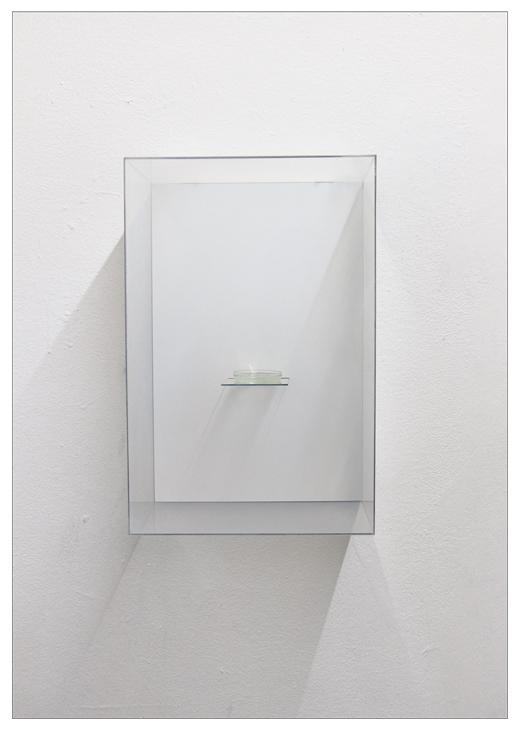lebt in Wien
Vitrine
„o.T.“ (Flabeg Control UV60 Glas, weiß beschichtetes MDF, Salzsäure rauchend 38%.), 2011
43*28*13,8cm

2 Ag + 2 HCl →2 AgCl + 2H+ + 2e-
Michael Part’s Hydrochloric acid fuming object is a presentation of hydrochloric acid fuming – an active acid that theoretically will turn any silver gelatine photography white/white and light sensitive. Presented in a glass case mounted to the wall, the fume resembles fog and looks like an appropriation straight out of a chemical laboratory. As it is displayed it becomes a process oriented object of its own, filled with fascinating opportunities of theoretical concerns regarding photography, abstract art, narration, history and colour theory.
1872 Wilhelm Burger was the commissioned landscape photographer on an Austrian-Hungarian North Pole expedition financed by Count Johann Wilczek. Burger returned with many albumin prints* , including one of the rocky landscape and fog, where Burger had placed his theodolit in the picture, presumably to gain more depth. I remembered this immediately when Part came to me one day telling me about his newest experiment – the white/white photography of fog. I doubt that the Austrian-Hungarian Empire would have been very pleased with Burger returning with white/white prints from Franz-Joseph’s land – but seen in relation to history of literature and psychology, it is intriguing. Fog, the Arctic Zone, snow, expedition – the white whiteness, a blinding whiteness must have been a poignant, existential experience. A white/white photography would be a depiction not of how fog looks in terms of landscape photography, but how it is actually being trapped in fog, lost in whiteness.
The hydrochloric acid fuming is a determining point in attaining this monochromatic existential photography. Part had already tried other chemical processes that failed before he turned to the Viennese Colour Technical Institute of the Academy of Fine Arts. The fruitful discussion that evolved remains highly theoretical – silver chloride* is chemically classified as white, hence proposing a solution to making a white/white photography, but; if a silver gelatine photography would be exposed to hydrochloric acid directly the gelatine coating would be destroyed.
By constructing a device (e.g. a container with a hydrochloric acid atmosphere) that enables setting the photography in contact with only the fume should theoretically work – meaning it would make the silver* react with hydrochloric acid resulting in white silver chloride, resulting in a white on white monochrome. Interestingly, it theoretically wouldn’t end there – the thus gained status is in itself a return to a photographic starting point – the newly attained surface is again light sensitive, so if left in the open it would eventually gradually turn black or it could be re-developed – either back to the black/white original image or to any new image of momentary interest.
Is black or white the non-colour that contains every spectrum of the light (every colour) or is it black or white that reflects every spectrum of the light (every colour) back to the eye? I had an argument with my brother over that question in elementary school after physics class. Now I remember it because the thought of a monochrome square that over an unknown amount of time would turn from white to black fascinates me. It is like an object from a futuristic novel, able to record history over an extensive period, communicating only on a highly abstract level.
Exhibited is only hydrochloric acid fuming object, the chemical catalyst to these theoretical possibilities – appropriately itself looking like fog.
K
*1. At that time the most modern negatives were collodium plates. Burger used this technique for making his landscape photography. The collodium plates have to be made light-sensitive right before exposure, so Burger was practically carrying an entire photographic laboratory with him in the arctic areas. These negatives were then printed on albumin papers.
*2. Silver chloride accrues when silver is exposed to hydrochloric acid. Hydrochloric acid attacks organic materials, e.g. the silver gelatine coating.
*3. The density of silver in a silver gelatine print makes out the black and gray-scales.
(http://www.bildarchivaustria.at/Pages/Praesentation.aspx?p_iAusstellungID=12668818&p_iPage=17&p_ItemID, abgerufen: Di. 15.02.2011, 22:56)